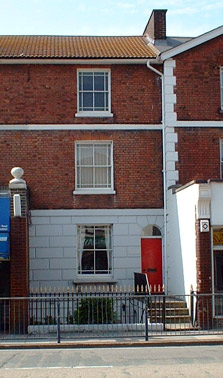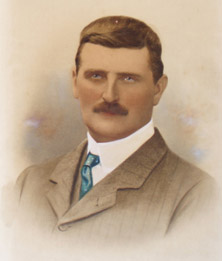Colonel Stephens
Holman Fred Stephens (1868-1931) is
remembered for his involvement in the engineering and management of a collection
of minor railways, which he ran – in an eccentric and autocratic style – from
his office in Tonbridge.
After briefly studying engineering at University College, London, Stephens
became a pupil of the Locomotive Superintendent of the Metropolitan Railway
before moving on to gain experience of civil engineering. A first position as
Resident Engineer on the Paddock Wood to Hawkhurst line (opened in 1893) led
gradually to involvement in other projects in the same area. In 1895 he rented
rooms for home and office at Ashby House, No. 1 Priory Road, Tonbridge, adjacent
to Quarry Hill Road. As his practice grew he set up the office on the opposite
side of Quarry Hill Road at 23 Salford Terrace, in 1900. These two premises
served Stephens for the rest of his life.

The Salford Terrace premises in 2008 (photo: Tony Mortlock)
From the Salford Terrace office Stephens managed contracts for railway construction
in the earlier years and the running of several small railways, mostly operating
after World War 1 on a hand-to-mouth, make-do-and-mend basis, spread from Kent
to Snowdonia. After his death in 1931, responsibility was assumed by his
assistant, William H. Austen until the last remnants were swept up by
nationalisation of the railways in 1948. (Austen worked for Stephens from c1895
and moved to 13 Douglas Road, Tonbridge when the Salford Terrace office was
acquired; he later had a house built in Deakin Leas (No. 26).)
Stephens was a long-term member of the Territorial Army (as it became),
having reached the rank of Major by 1914. He served in the Royal Engineers until
1916 when he returned to civilian railway work with the rank of Lieutenant
Colonel – a title he continued to use thereafter.
All of the Colonel Stephens railways have now closed, with the exception of
one in Devon, though several – including the Tenterden to Bodiam stretch of the
Kent and East Sussex Railway – have subsequently been reopened by enthusiasts.
In Tonbridge, the Priory Road site later became Rawson’s Garage and is now
flats. The Salford Road premises remain largely unchanged externally. Furniture
and other items from it are displayed in the Colonel Stephens
Railway Museum at Tenterden.
One of the ventures Stephens was
associated with, though it never came to fruition, was the proposed Hadlow Light
Railway. This would have run from a station in the Tonbridge east goods yard
(now car park) in Vale Road, through the Angel Centre site, across Botany at a
level crossing, then over the Medway and the flood plain to a North Tonbridge
station in Hadlow Road. It then followed the route of the A26 to Hadlow
Junction, from which one branch would have gone north to Plaxtol and Basted
while the other led east to Yalding.
Holman Stephens never married. He died in a Dover Hotel in 1931 and is buried
in London at Brompton Cemetery. A
Colonel Stephens Society was set up in 1985.
▲Top


